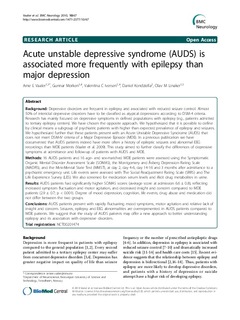Acute unstable depressive syndrome (AUDS) is associated more frequently with epilepsy than major depression
Journal article, Peer reviewed
Permanent lenke
http://hdl.handle.net/11250/2353165Utgivelsesdato
2010Metadata
Vis full innførselSamlinger
Sammendrag
Background: Depressive disorders are frequent in epilepsy and associated with reduced seizure control. Almost
50% of interictal depressive disorders have to be classified as atypical depressions according to DSM-4 criteria.
Research has mainly focused on depressive symptoms in defined populations with epilepsy (e.g., patients admitted
to tertiary epilepsy centers). We have chosen the opposite approach. We hypothesized that it is possible to define
by clinical means a subgroup of psychiatric patients with higher than expected prevalence of epilepsy and seizures.
We hypothesized further that these patients present with an Acute Unstable Depressive Syndrome (AUDS) that
does not meet DSM-IV criteria of a Major Depressive Episode (MDE). In a previous publication we have
documented that AUDS patients indeed have more often a history of epileptic seizures and abnormal EEG
recordings than MDE patients (Vaaler et al. 2009). This study aimed to further classify the differences of depressive
symptoms at admittance and follow-up of patients with AUDS and MDE.
Methods: 16 AUDS patients and 16 age- and sex-matched MDE patients were assessed using the Symptomatic
Organic Mental Disorder Assessment Scale (SOMAS), the Montgomery and Åsberg Depression Rating Scale
(MADRS), and the Mini-Mental State Test (MMST), at day 2, day 4-6, day 14-16 and 3 months after admittance to a
psychiatric emergency unit. Life events were assessed with The Social Readjustment Rating Scale (SRRS) and The
Life Experience Survey (LES). We also screened for medication serum levels and illicit drug metabolites in urine.
Results: AUDS patients had significantly higher SOMAS scores (average score at admission 6.6 ± 0.8), reflecting
increased symptom fluctuation and motor agitation, and decreased insight and concern compared to MDE
patients (2.9 ± 0.7; p < 0.001). Degree of mood depression, cognition, life events, drug abuse and medication did
not differ between the two groups.
Conclusions: AUDS patients present with rapidly fluctuating mood symptoms, motor agitation and relative lack of
insight and concern. Seizures, epilepsy and EEG abnormalities are overrepresented in AUDS patients compared to
MDE patients. We suggest that the study of AUDS patients may offer a new approach to better understanding
epilepsy and its association with depressive disorders.
